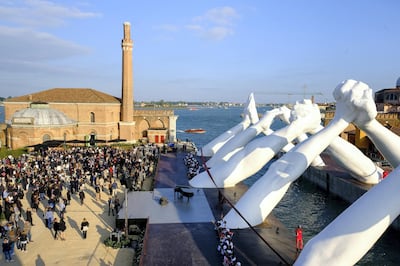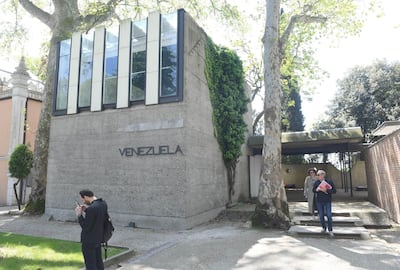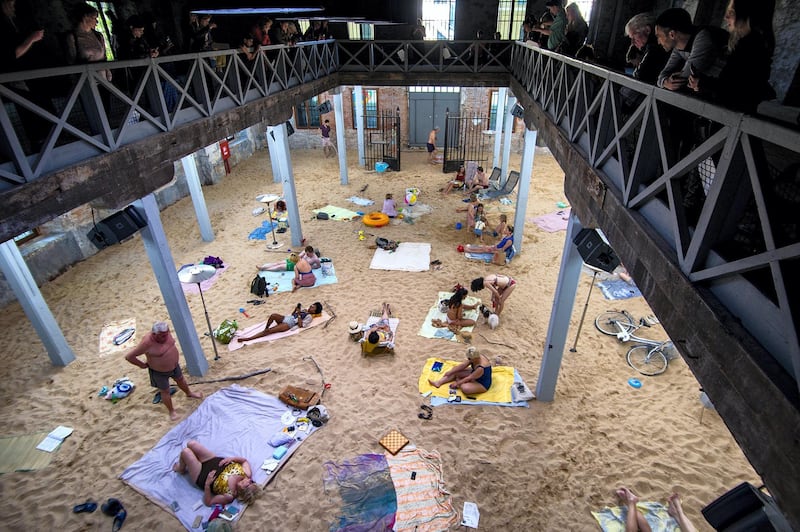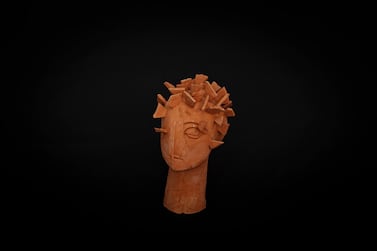“I can’t imagine a less sustainable biennial than the Venice Biennale,” says Claudia Fontes, who represented Argentina at the art event in 2017. “It is like how Venice is sinking as a city.”
The Venice Biennale is typically associated with parties in palazzos, with its line of super-yachts overlooking visitors as they shuttle between the event's two main venues of the Arsenale and the Giardini.
A 19th-century array of power
It resembles an art Olympics, of sorts, with each country nominating a representative for its national pavilion. An invited curator, this year, Ralph Rugoff of the Hayward Gallery in London, also puts together a sprawling group exhibition across two venues that is seen as agenda-setting, or at least as an expression of the zeitgeist. The current show, May You Live in Interesting Times, received a lukewarm reception, though it includes some strong works.
The Olympics set-up is largely anachronistic, but has the effect of keeping the international distribution of power front and centre in people's minds. If one pavilion sums up this year's event, it might be Venezuela's. The building is padlocked shut; fallen leaves and sundry building material have been left lying by the entrance. The Venezuelan government, in the throes of its ongoing political crisis, had been unable to release the pavilion's funds in time for the biennale's opening last week. And for more pavilions than just Venezuela, the finances behind artists' participation at the Biennale are becoming evermore precarious.
The Giardini was built at the eastern end of Venice in marshes reclaimed under Napoleon's reign. Countries built permanent pavilions for the first biennial, in 1895, and the site still bears the contours of that era's politics. Britain, then the world's pre-eminent colonial power, sits atop a hill, lording it over one of the two main arteries; Italy, the home country, sits at the end of the other one. A second area in the Giardini, reached via a bridge, has later, apparently lesser additions to the biennale, such as pavilions for Austria, Egypt and Brazil.
Today, the Giardini is an index of how times change: there are some throwbacks, such as the Czechoslovakian Pavilion and, in the Arsenale, pavilions for new non-European powerhouses, such as China, India, the UAE and Saudi Arabia, which can afford the high rents in the recently converted section there.

But though representation remains a national priority for most countries, the funding for each varies. Core financing typically comes from a ministry of foreign affairs or culture ministry, or an independent charitable body that receives funds from the government, such as the British Council in the UK. The UAE’s pavilion is run by the National Pavilion, which is funded by the Sheikha Salama bint Hamdan Foundation and the UAE Ministry of Culture and Knowledge Development. Artists and curators then solicit money from foundations and private donors for the rest.
But more artists from countries with limited resources (only some of whom wanted to speak on the record) have found representing their national pavilions to be a financially and logistically stressful experience, barely worth the kudos and recognition it brings.
Artists pick up the slack
For less affluent nations, a common problem is that funds are released from the government too late. Argentine artist Fontes, for example, was told at the end of August 2016 that she had been selected for the Venice Biennale. She started work on her project, a resin and marble-dust installation of rocks, a horse, and depictions referring to 19th-century public figures in Argentina, mixed with a recognition of the hidden labour provided by animals such as horses in the Arsenale, where her exhibition was housed.
The show was due to open on May 8, but Fontes did not receive any funds from the Argentinian government to start producing the piece until one month before. By that time, Fontes, who had already started the work so it would be ready in time, had gone into debt, borrowing money from collectors. "I had to fundraise, meet solicitors, protect my family, my house," she says. "I was like a one-woman company."
Because of the scale of the project, she wasn't able to take on any other work for the eight-month period before the show. "Was it worth it?" she asks. "It was very traumatic. Only now, two years on, can I enjoy what happened. The more you talk to different people, you realise the stories are different, but the level of stress is the same."
Jimmy Ogonga, an artist who curated a show of four artists for the Kenyan pavilion in 2017, faced a similar situation when elections in Kenya occurred during the time funds were supposed to be transferred for the pavilion – but never were. "Once our request was at the treasury, nothing happened," he says. "We simply waited and waited. The few weeks before May 2017 – when the biennale opens – were a mixture of anxiety, speculation and, of course, deep frustration. Out of the entire budget, which had been approved at both ministry and cabinet levels, not a cent was ever released."
With weeks to go, Ogonga was able to cobble together funding from private sources – from curator Simon Njami, the Factory House in Lamu, Venice's Zuecca Projects, Hausbrandt coffee and the Dutch foundation DOEN – and he speaks warmly of support in the international art world, especially among the other African pavilions.
But the experience was disheartening and difficult to rebound from. They had to give up their original space, for which they'd enlisted architect David Adjaye, and they ended up with what he calls a "suitcase exhibition" of artworks brought in via the artists' and curators' luggage. "Ultimately, the frustration and chaos of the moment caused a disintegration of the technical team in Nairobi," Ogonga says. "This frustration then mutated into animosity, then mistrust, and other variations of paranoia that start leading towards self-destruction. There were multiple conflicting calls from anyone who cared. Some advised us to abandon the pavilion altogether. We were faced with prospects of catastrophic failure and, naturally, this was a bitter pill to swallow, particularly for the artists who formed the technical team and those selected for the pavilion.
“When I came back home from Venice, I was exhausted,” he says. “I was broke from working for two years non-stop without an income, and broken, physically and emotionally.”
Is prestige enough?
Payment in exposure and the prospect of future sales is common throughout the art world, particularly in biennials, which confer the greatest amount of stature on an artist. Fees for biennials, which are usually funded by the municipal government of the city where they are based, typically range from zero to $2,000 (Dh7,345). Curators and biennial organisations fundraise to cover some of the other costs, which include the materials required to construct the work, the shipping of these materials, flights and accommodation in the biennial city, and the salaries and associated costs of hiring a technical team to install the work at the biennial, if this is not provided by the biennial itself.
The Venice Biennale typically does not provide fees for the artists in its main exhibition. Artists, who do not have access to government funding, frequently ask their galleries for financial assistance, but, as one artist who has participated both in a national pavilion and the international show told me, "Then you have to split the cost of any sale of the work with them".
This year, there was a feeling throughout the biennale of money talking more than ever. The first three days before its opening are usually reserved for art professionals – critics, artists, gallerists and curators. Last week, the Biennale di Venezia organisation for the first time had decided to allow collectors to buy tickets at €500 (Dh2,058) each. Many blamed the intense crowds of the preview days on this decision to widen the entry parameters. There was also a noticeable reliance on artists who have gallery representation. "It's the best art fair I've ever seen," went the running joke about the main exhibition, May You Live in Interesting Times. By my count, of the 80 artists in the show, only six do not have gallery representation. And the off-site exhibitions were all by artists backed by major galleries, from Gagosian (Helen Frankenthaler, Georg Baselitz, Edmund de Waal) to Hauser & Wirth (Arshile Gorky and Gunther Foerg). At what point does Venice become too expensive for those who don't have financial backing?
Artists and curators are taking gambles
The costs of Venice also determine what medium of work can be shown. Lucia Pietroiusti curated the phenomenal Lithuanian Pavilion this year: the opera Sun & Sea (Marina) by theatre director Rugil Barzdziukait, writer Vaiva Grainyt and composer Lina Lapelyt, who frequently collaborate. The work exists as part performance, part installation. Visitors look over an internal balcony on to an indoor beach, where sunbathers lie lit by heat lamps and fake sunlight. Children play in the sand, girls in bikinis listen to music, an older couple sit in beach chairs, a dog by their side. The actors are all trained opera singers, who break out into low, murmuring arias or choral songs, amplified in the space via their barely noticeable flesh-coloured microphones. The music is beautiful and the spectacle extraordinary – and expensive. Because of the costs involved, Pietroiusti and the artists decided they would perform the work during the preview days, and then every Saturday throughout the course of the biennial.

But, come opening week, they didn't have the money to go far beyond the preview. "There's a lot of desire for performative work, but performative work is more expensive and requires a different kind of curatorial and production care," says Pietroiusti, who works as a curator at the Serpentine Galleries in London. "Oftentimes you find that performance artists get invited by an institution, but the institution asks for a reduced scale version. My feeling was always, you know what, if the money runs out, then it runs out, and it makes a statement about what it takes to do performance and to do it well."
The Pavilion received €174,000 from the Lithuanian Council for Culture, and privately fundraised €100,000. Their gamble, during the preview, was simply to open and leverage any success towards further funding. "There was a strong sense of, we're going to just do this and we're going to see how it goes," says Pietroiusti. "We opened with a great sense of optimism, where we thought once people see this piece, if enough people see this piece, if the piece does well, we would get more funding. We had a sense of the piece doing well, but we had no notion of the success or impact it went on to have."
The work is this year's winner of the Biennale's Golden Lion for best pavilion. It went from welcoming 17 people at the preview on Tuesday to thousands on Friday, when word of mouth had filtered through the biennial audience. By the time the prize was announced on the Saturday, the queues were three hours long. One altercation grew so heated, a rumour of a bomb threat developed, and the pavilion had to be temporarily closed.
Despite this amount of attention, the pavilion is still €60,000 short of being able to stay open until November. "We've had some interest, Pietroiusti says. "People say they want to help. This week my hope is just to follow up and confirm. I'm still optimistic."







